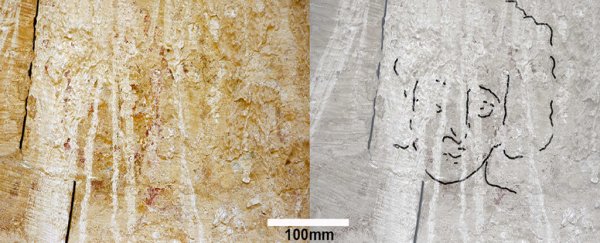The crimson pigment is sun-bleached, its eroded lines barely visible against the texture of the plaster. But with effort, you can see a face that once decorated an ancient Christian baptismal in southern Israel. And it's not what you'd expect.
Most historical depictions of Jesus follow a familiar pattern, giving us an iconoclastic image of the Christ figure. This painting represents the first of its kind, and the man it shows looks remarkably different to the one we're used to.
Archaeologists had discovered the painting itself back in the 1920s, when it earned a brief mention in an old journal. But thanks to its poor state of preservation, it hadn't attracted further attention until recently.
In fact, the image is so faded, even modern art historians could barely make it out.
"I was there at the right time, at the right place with the right angle of light and, suddenly, I saw eyes," Emma Maayan-Fanar from the University of Haifa told Ruth Schuster at Haaretz.
"It was the face of Jesus at his baptism, looking at us."
In an archaeological game of dot-to-dot, the researchers pieced together a rough idea of what the head might have looked like once.
Forget the beard and flowing locks of the more western-looking icon; this young man was clean shaven, with a long nose, and curly hair.
Surrounding the figure were traces of pigment that suggested the presence of other key religious figures. Given it was also located high up inside the baptismal apse of a church, it's a fairly solid assumption that this was a young Jesus at his baptism.
 This is the position of the art high on the baptismal wall. (Dror Maayan)
This is the position of the art high on the baptismal wall. (Dror Maayan)
An art piece found relatively nearby representing an older Christ at his transfiguration was reported on by the same team last year. Unfortunately, the head of that figure hadn't survived the ravages of time, leaving just a handful of details.
Both artworks decorate the walls of churches in the ancient town of Shivta, which is now a dig site in southern Israel.
After being founded roughly 1,800 years ago, it would have grown into a sizeable farming village on what is likely to have been a popular pilgrimage route.
While archaeologists have been sifting through the ruin for more than a century, nobody has been able to put an exact time on the church's construction.
Before you get too excited, the absolute earliest date of the painting would still be a good two centuries after the death of Jesus, making it unlikely to be an informed likeness drawn from the real deal.
The churches are likely to be younger than that anyway. The town's most affluent period was between the fifth and seventh centuries, just before the population dwindled in the wake of Arab conquests.
It might not be an accurate portrait of a young Christ, but that isn't what has historians excited anyway. The art piece is old enough to be the first pre-iconoclastic baptism scene yet found in the Holy Land.
Early depictions of Christ abound in old churches across much of the Mediterranean, at least to the west of the Levant region. But in the Middle East, art works featuring Jesus weren't all that common. And where they might have existed, most have been destroyed or at least removed from their place of creation.
This makes it a one-of-a-kind painting.
For the differences in face and hairstyle, there are a few features which show consistency with other baptismal scenes. For example, the figure assumed to be John the Baptist is larger than Christ in the painting, just as it is most depictions.
With further study, the historians might be able to make out other images amid the specks of old paint, and continue to identify how its iconography relates to similar pieces around the world.
As to whether Jesus might have really looked this way, the argument is nearly as old as the painting itself. Early 6th century CE texts have reportedly debated the kind of hairstyle the reported Son of God would have had.
It's easy to assume Christ might have had a Middle Eastern appearance, yet this isn't as simple as we might assume.
Physiological characteristics common in today's populations – such as dark eyes and shorter hair – might not have been as common as we assume in ancient times, as genetically distinct populations came and went throughout the land.
What does seem to be clear from the multitude of depictions across the centuries and around the globe is that Jesus looks like those who follow him, adapting to suite tastes in fashion, cultural experience, and custom.
Which means art pieces like this one really tell us far more about the artists than they do about the subject.
This research was published in Antiquity.
